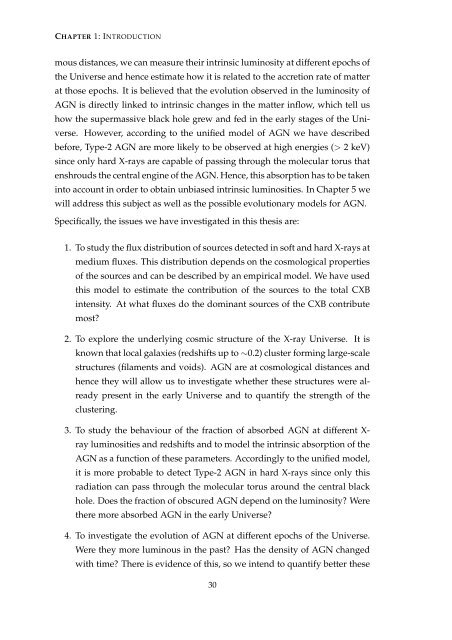pdf - SRON
pdf - SRON
pdf - SRON
You also want an ePaper? Increase the reach of your titles
YUMPU automatically turns print PDFs into web optimized ePapers that Google loves.
CHAPTER 1: INTRODUCTION<br />
mous distances, we can measure their intrinsic luminosity at different epochs of<br />
the Universe and hence estimate how it is related to the accretion rate of matter<br />
at those epochs. It is believed that the evolution observed in the luminosity of<br />
AGN is directly linked to intrinsic changes in the matter inflow, which tell us<br />
how the supermassive black hole grew and fed in the early stages of the Universe.<br />
However, according to the unified model of AGN we have described<br />
before, Type-2 AGN are more likely to be observed at high energies (> 2 keV)<br />
since only hard X-rays are capable of passing through the molecular torus that<br />
enshrouds the central engine of the AGN. Hence, this absorption has to be taken<br />
into account in order to obtain unbiased intrinsic luminosities. In Chapter 5 we<br />
will address this subject as well as the possible evolutionary models for AGN.<br />
Specifically, the issues we have investigated in this thesis are:<br />
1. To study the flux distribution of sources detected in soft and hard X-rays at<br />
medium fluxes. This distribution depends on the cosmological properties<br />
of the sources and can be described by an empirical model. We have used<br />
this model to estimate the contribution of the sources to the total CXB<br />
intensity. At what fluxes do the dominant sources of the CXB contribute<br />
most?<br />
2. To explore the underlying cosmic structure of the X-ray Universe. It is<br />
known that local galaxies (redshifts up to ∼0.2) cluster forming large-scale<br />
structures (filaments and voids). AGN are at cosmological distances and<br />
hence they will allow us to investigate whether these structures were already<br />
present in the early Universe and to quantify the strength of the<br />
clustering.<br />
3. To study the behaviour of the fraction of absorbed AGN at different X-<br />
ray luminosities and redshifts and to model the intrinsic absorption of the<br />
AGN as a function of these parameters. Accordingly to the unified model,<br />
it is more probable to detect Type-2 AGN in hard X-rays since only this<br />
radiation can pass through the molecular torus around the central black<br />
hole. Does the fraction of obscured AGN depend on the luminosity? Were<br />
there more absorbed AGN in the early Universe?<br />
4. To investigate the evolution of AGN at different epochs of the Universe.<br />
Were they more luminous in the past? Has the density of AGN changed<br />
with time? There is evidence of this, so we intend to quantify better these<br />
30
















